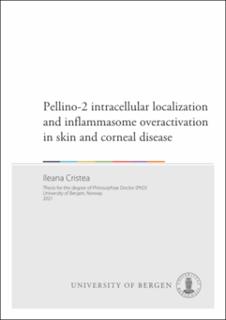| dc.description.abstract | Background: Ocular pterygium-digital keloids dysplasia (OPDKD) is a rare, genetic disorder characterized by early onset corneal overgrowth and later development of keloids on distal limbs. We identified a de novo PELI2 germline mutation in a family with OPDKD. Pellino-2 is part of the Pellino family of E3 ubiquitin ligases, involved in the innate immune system. Pellino-2 has been linked to the activation of the NLRP3 inflammasome.
Objectives: Little was known about Pellino-2 at the beginning of this project. The overall aim of this thesis has been to examine Pellino-2 in greater detail with particular focus on how the identified mutation could lead to OPDKD.
Aims paper 1: To analyze the interplay between Pellino-2 and NLRP3 in the activation of the NLRP3 inflammasome.
Aims paper 2: To identify novel interaction partners of Pellino-2 and characterize Pellino-2 localization in non-immune cells.
Aims paper 3: To report and characterize the PELI2 variant in an OPDKD patient.
Methods:
Paper 1: Immunofluorescence, ELISA, immunoblotting
Paper 2: Yeast two-hybrid, co-immunoprecipitation, subcellular fractionation, immunoblotting, immunofluorescence, live cell imaging
Paper 3: Trio exome sequencing, immunofluorescence, co-immunoprecipitation, cycloheximide chase assay, ELISA, cell viability assay
Results:
Paper 1: Pellino-2 was constitutively expressed in THP1-derived macrophages. Pellino- 2 changed intracellular localization upon NLRP3 inflammasome activation, and co- localized with both NLRP3 protein and ASC protein in the late stages of inflammasome assembly. The interaction between Pellino-2 and NLRP3 and ASC, and thus NLRP3
1 inflammasome activation, was initiated by low levels of extracellular K+. The relocation of Pellino-2 and the NLRP3 inflammasome activation was blocked by various K+ channel blockers.
Paper 2: Six novel interaction partners of Pellino-2 were identified: ROBO-1, DVL-2, NEK9, IRS-1, cyclin F and TRAF7. Pellino-2 intracellular localization was proven to be dependent on K+ efflux, also in non-immune cells. Live cell imaging confirmed that Pellino-2 is a dynamic protein, that can change intracellular localization. This provides an explanation for its interaction partners being located in various intracellular compartments.
Paper 3: In an OPDKD patient, a de novo PELI2 variant c.770C>T p.(Thr257Ile) was identified. The substitution did not affect Pellino-2 intracellular localization, its binding to its interaction partners, or its stability. However, in U87MG cells transduced with the Thr257Ile variant, a constitutive activation of the NLRP3 inflammasome was observed.
Conclusions:
In this thesis, we characterized endogenous Pellino-2 in immune and non-immune cells. We showed that Pellino-2 acts as a potential K+ sensor that changes intracellular localization following K+ efflux. In immune cells, Pellino-2 relocates to the activated NLRP3 inflammasome, and in non-immune cells, to the nucleus.
Further, we expanded the list of interaction partners of Pellino-2, opening new avenues of research for Pellino-2 and the signaling pathways in which these proteins are involved: cell migration via ROBO-1, epithelial-mesenchymal transition via DVL-2, insulin signaling via IRS-1, or cell division via cyclin F and NEK9. Our data suggest that Pellino-2 is a dynamic protein that can move within the cell to reach its interaction partners.
Lastly, we reported a novel mutation in PELI2 that appears to constitutively activate the NLRP3 inflammasome. This provides a potential mechanism for inflammation and tissue overgrowth in OPDKD. | en_US |
| dc.relation.haspart | Article III: Ileana Cristea, Hugo Abarca, Anne EC Mellgren, Roya Mehrasa, Gunnar Houge, Raoul CM Hennekam, Eyvind Rødahl, Ove Bruland, Cecilie Bredrup. A de novo PELI2 variant associated with constitutive NLRP3 inflammasome activation. Not available in BORA | en_US |
